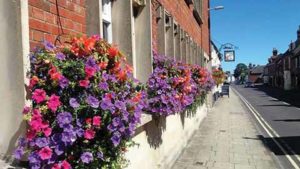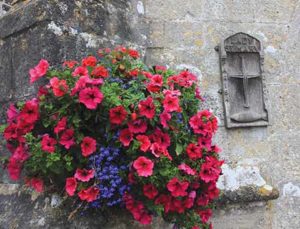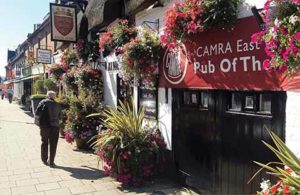Try, try, try again
John Newth gives the background to Wareham’s outstanding performance in this year’s national Britain in Bloom competition
Published in December ’17
On the last Friday evening in October, the Chairman of Wareham in Bloom, Eric Osmond MBE, was sitting anxiously by his phone. Three hundred miles away, in Llandudno on the North Wales coast, the winners of the national finals of the Britain in Bloom competition were being announced. Wareham was among the finalists in the Small Town category and, prevented by personal reasons from attending the award-giving, Eric was having to rely on others to convey the news of whether the Herculean efforts of himself and his committee had been crowned with success. Alas, although this was Wareham’s third appearance in the national finals, it was not to be third time lucky as Uppingham in Rutland and Randalstown in Ulster shared the top prize. Eric took the news philosophically but was already looking ahead to the future with renewed determination: ‘We’ll be back,’ he said.
Britain in Bloom is run by the Royal Horticultural Society and is organised into sixteen regions; Wareham is in the South/South East region. It is further divided into twelve categories: for example, small village, large town, city, as well as the small town category in which Wareham competes. Every community that enters is visited by two judges and marked according to a standard set of criteria. Depending on how many marks it gets, an entrant may be given a bronze, silver, silver gilt or gold award. There can be any number of each type of award within a region, but the competitive element comes in when the judges nominate a winner in each category for the region. Participation in the following year’s national final is by invitation, but category winners who have scored well can usually expect to be included.
Although Eric Osmond modestly credits the contribution of others, he has been ‘Mr Wareham in Bloom’ since its inception (as well as sitting on Purbeck DC for twelve years, three of them as Chairman, and serving as Mayor of Wareham three times). Joining the Town Council in 1990, he always felt that the approach to the town from the north was rather drab. In 1994 he was told of 20,000 daffodil bulbs that had become available and over the course of four or five weeks enlisted friends and neighbours to help plant them. Today they are well established and as you drive into the town in spring, you are greeted by a carpet of yellow on both sides of the road. Some of those friends and neighbours became the nucleus of the Wareham in Bloom committee, which was formed in that year.

Looking up East Street at the colourful baskets which seemed to grace almost every wall in Wareham this summer
The whole venture has grown to the point where the committee now has 110 pieces of display equipment. It also looks after various flower beds around the town. Most of the displays are sent away to be planted, with petunias, geraniums and lobelias usually predominating, and when they return in several lorry-loads, it is all hands on deck to distribute the hanging baskets, towers, stands, tubs, hay racks and so on around the town. Businesses will have been approached to take a display – such is the support in the town that they not only pay for the privilege but undertake to look after the display as well.
The flowers on the library and town hall are watered automatically, but everything else is looked after by a team of forty volunteer waterers. All the equipment is of a height where the flowers can be watered from ground level to avoid climbing ladders or standing on wobbly chairs. The waterers can also check on the general condition of the displays including – sadly – any vandalism. They are encouraged where possible to take the water from the River Frome, which plants prefer to the chemically treated mains water. Eric Osmond himself can often be seen at 5 o’clock on a summer’s morning, filling containers from
the river!

A display of geraniums, petunias and lobelias sets off the carved wooden sign on the wall of the church of Lady St Mary
Credit: Sue Kemp
Some of the waterers are also part of the dead-heading team that is busy in the days leading up to the judging, ensuring that the displays are looking their very best.
Entering Britain in Bloom is only part of what Wareham in Bloom is about. It also encourages to residents to take pride in the appearance of their town, particularly its flowers and gardens, by organising competitions in several categories – best front garden, best pub and so on. Some eighty people attend the prize-giving in October, which is evidence of the strong community support for the project. The committee also fosters links with local schools, a particular interest of the vice-chairman, retired teacher Maria Lockey.
Community involvement is an important element in the Britain in Bloom philosophy and is something for which the judges look out particularly. The whole competition is about more than flowers, and entrants are marked on things like the absence of litter, signage, safety, the smartness of street furniture (the Wareham in Bloom volunteers are dab hands with black and gold paint) and the maintenance of fences, pavements etc. Successful towns also show something new each year; for example, the Wareham in Bloom committee bought from BT for £1 one of the red telephone boxes in North Street, near the Town Cross, and re-installed the old buttons A and B. For older residents, it brings back childhood memories of never passing a phone box without popping in and pressing button B in case anyone had forgotten to reclaim their four old pennies!
A similar example is the restored pump at the bottom of South Street, near the bridge. Before mains water reached Wareham in the early 20th century, there were eight of these in the town. One of them was rescued by builder and long-term Wareham resident Jack Spiller, who put it in his garden, but Eric Osmond’s persuasiveness and his own generosity led him to donate it to the town. The local freemasons paid for its refurbishment and it is now connected to the mains, although it works like a tap and does not need to be pumped.


When the original replica sword (bottom) was stolen from the Saxon roundabout in 2011, it was speedily replaced; this was the unveiling ceremony for the new sword (top)
Perhaps the most conspicuous of all Wareham in Bloom’s projects is the roundabout at the northern end of the town. Earthen banks were thrown up on three sides to represent the walls of Wareham with, on the south side, a line of horizontal slate standing in for the Frome. Within the ‘walls’ is a feature created from local stone. The most controversial feature was a sword thrust into the topmost stone. It represented the sword found in the bed of the river when the new South Bridge was being built in 1927; dating from the Saxon era, its ornate decoration suggests that it almost certainly belonged to a member of the nobility. However, the Arthurian implications of a sword in a stone confused some people because, despite the town’s distinguished past, Arthur is one historical figure with whom Wareham has no connection. Maybe it was one of those puzzled people who spirited the sword away one night in 2011 – or, more likely, someone with more interest in its scrap value than its historical associations. The sword has been replaced by a rather more modest version.
Across from the roundabout, next to the caravan park, is a more recent Wareham in Bloom project: the Saxon Magic Corner, so named by a pupil at Wareham St Mary Primary School. The area was anything but magic, covered in scrub and dying willow trees. It was cleared and 120 tons of topsoil brought in, ready for the planting of 1800 shrubs and herbaceous plants. Eco Compost in Christchurch supplied free compost, which still had to be transported and then spread, but the hard work was more than rewarded by the final result.

Lots of businesses go above and beyond the call of duty, adding their sumptuous displays to that of Wareham in Bloom. Pubs especially have wonderful displays.
The committee is in fact a sub-committee of the Town Council, which is extremely supportive and helps with things like storage and some of the admin. However, it makes no direct financial contribution to Wareham in Bloom, which has to cover its costs of between £6000 and £7000 a year by sponsorship, fund-raising and help in kind. In particular, Peter Andrews of the eponymous plant hire and haulage company has always been ready to help with transport and the loan of heavy equipment, while Simon Goldsack of Holme for Gardens has lent moral and practical support throughout. From its funds earmarked for community projects, Viridor, the waste disposal company, weighed in with a valuable £1000 in the early days.
This year, Wareham was once again the South/South East winner in the small town category, so may reasonably expect an invitation to compete in the national finals in 2018. Whether or not it is fourth time lucky, competing with other towns is not the whole story. As you breast the hill by St Martin’s Church, a glorious vista of floral displays stretches ahead down both sides of North Street. It would be a hard heart that does not lift at the sight – and that, in the end, is surely what Wareham in Bloom is all about.


